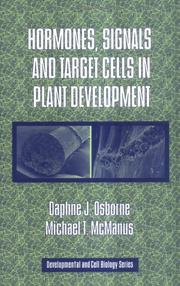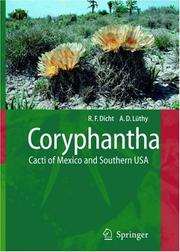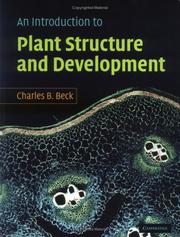| Listing 1 - 5 of 5 |
Sort by
|

ISBN: 0521330769 9780521330763 9780511546228 9780521177450 0511115857 9780511115851 0511122136 9780511122132 051154622X 1280153075 9781280153075 0521177456 1107141435 9786610153077 051119871X 0511299591 051111530X Year: 2005 Publisher: Cambridge : Cambridge University Press,
Abstract | Keywords | Export | Availability | Bookmark
 Loading...
Loading...Choose an application
- Reference Manager
- EndNote
- RefWorks (Direct export to RefWorks)
Meristematic cells in plants become the many different types of cells found in a mature plant. This is achieved by a selective response to chemical signals both from neighbouring cells and distant tissues. It is these responses that shape the plant, its time of flowering, the sex of its flowers, its length of survival or progress to senescence and death. How do plants achieve this? This treatise addresses this question using well-chosen examples to illustrate the concept of target cells. The authors discuss how each cell has the ability to discriminate between different chemical signals, determining which it will respond to and which it will ignore. The regulation of gene expression through signal perception and signal transduction is at the core of this selectivity and the Target Cell concept. This volume will serve as a valuable reference for all researchers working in the field of plant developmental biology.
Plant cellular signal transduction. --- Plant hormones. --- Plants --- Plant and Crop Sciences. Botany --- Development. --- Plant Development. --- Development of plants --- Plant development --- Developmental biology --- Growth (Plants) --- Cellular signal transduction --- Plant cellular control mechanisms --- Hormones (Plants) --- Phytohormones --- Hormones --- Phytochemicals --- Plant regulators --- Ontogeny

ISBN: 1280234733 9786610234738 3540267956 3540223061 364206096X Year: 2005 Publisher: Berlin, Heidelberg : Springer Berlin Heidelberg : Imprint: Springer,
Abstract | Keywords | Export | Availability | Bookmark
 Loading...
Loading...Choose an application
- Reference Manager
- EndNote
- RefWorks (Direct export to RefWorks)
This unique reference work presents the first comprehensive taxonomy of Coryphantha, with a complete key to the genus. It contains a new taxonomic classification of all 43 species and 11 subspecies, with morphological and ecological descriptions. These cacti, which grow in Mexico and southern USA, are characterized by their typical grooved tubercles and large flowers. The book is the result of many years of viewing the literature and fieldwork by the author team and their ongoing commitment to map out the nomenclature of this genus. During this process, the authors even discovered some new plants. More than 300 high-quality colour photos showing the various cacti and their habitats as well as distribution cards and illustrations explaining the morphological details complement the text. Written in an easy-to-follow style and with a chapter on cultivation conditions, the work will not only be an invaluable reference manual for taxonomists and horticulturalists but also for hobbyists and plant collectors.
Coryphantha --- Beehive cactus --- Pincushion cactus --- Cactus --- Botany. --- Plant anatomy. --- Plant Sciences. --- Plant Systematics/Taxonomy/Biogeography. --- Plant Anatomy/Development. --- Botany --- Plant structure --- Plants --- Structural botany --- Vegetable anatomy --- Anatomy --- Botanical science --- Phytobiology --- Phytography --- Phytology --- Plant biology --- Plant science --- Biology --- Natural history --- Structure --- Plant science. --- Plant systematics. --- Plant taxonomy. --- Plant development. --- Development of plants --- Plant development --- Developmental biology --- Growth (Plants) --- Botanical classification --- Botanical systematics --- Botanical taxonomy --- Classification --- Plant biosystematics --- Plant classification --- Plant systematics --- Plant taxonomy --- Systematic botany --- Systematics (Botany) --- Taxonomy, Plant --- Plant taxonomists --- Ontogeny --- Floristic botany

ISBN: 0521837405 9780521837408 9781139165365 9780521106962 Year: 2005 Publisher: Cambridge : Cambridge University Press,
Abstract | Keywords | Export | Availability | Bookmark
 Loading...
Loading...Choose an application
- Reference Manager
- EndNote
- RefWorks (Direct export to RefWorks)
An Introduction to Plant Structure and Development provides a comprehensive introduction to plant anatomy incorporating basic knowledge with information and ideas about the development of plant structure and form. Unlike many other plant anatomy textbooks, the 18 chapters incorporate information from the latest research in cellular and molecular biology as related to plant development. Topics include the integrative significance of plasmodesmata and the concept of the symplast, the concept of multicellularity, the role of the cytoskeleton in development, signal transduction, and the genetic control of development. Brief sections on evolution and function are also included. This textbook has been designed for undergraduate and graduate students with a basic knowledge of plant science. It is richly illustrated with numerous line drawings and photographs, closely integrated with the text, to aid students' understanding. In addition there is a comprehensive glossary and extensive bibliographies for further reading.
Plant anatomy --- Plants --- Development --- Plante --- plants --- Anatomie végétale --- plant anatomy --- Morphologie végétale --- Plant morphology --- Développement biologique --- biological development --- 581.4 --- #WPLT:syst --- Plant morphology. Plant anatomy --- Plant anatomy. --- Development. --- ANA Anatomy & Morphology --- plant development --- 21th century --- handbooks --- 581.4 Plant morphology. Plant anatomy --- Phytomorphology. Phytoanatomy --- Plant embryology and development --- Plants - Development --- Acqui 2006 --- Development of plants --- Plant development --- Developmental biology --- Growth (Plants) --- Botany --- Plant structure --- Structural botany --- Vegetable anatomy --- Anatomy --- Ontogeny --- Structure

ISBN: 1281043818 9786611043810 1402029853 1402029845 9048167590 Year: 2005 Volume: v. 77 Publisher: Dordrecht : Springer Netherlands : Imprint: Springer,
Abstract | Keywords | Export | Availability | Bookmark
 Loading...
Loading...Choose an application
- Reference Manager
- EndNote
- RefWorks (Direct export to RefWorks)
Earlier, we edited a well received series on "Somatic embryogenesis in woody trees", volumes 1 to 6. These volumes provided readers extensive reviews on somatic embryogenesis of important angiosperm and gymnosperm tree species; an excellent source of information for newcomers or those already engaged in research. However, these book volumes did not cover stepwise "detailed protocols" for inducing somatic embryogenesis. This book contains 46 chapters, divided into 4 sections: A) 12 chapters on conifers, B) 14 chapters on fruits, C) 14 chapters on angiosperms, and D) 6 chapters on histology, bioencapsulation, protoplasts, cryopreservation, double staining and thin cell layer sectioning. The book provides stepwise protocols for somatic embryogenesis of a range of selected woody plants in order to assist researchers to initiate somatic embryogenic cultures without too much alterations in protocols. Each chapter provides information on initiation and maintenance of embryogenic cultures; somatic embryo development, maturation, and germination; acclimitization and field transfer of somatic seedlings. Some chapteres include applications of somatic embryogenesis cultures, e.g. protoplasts, encapsulation, cryopreservation, genetic transformation, genetic fidelity with molecular markers, and bioreactor.
Woody plants --- Plant embryology. --- Somatic embryogenesis. --- Botany --- Plants --- Vegetable embryology --- Embryology --- Seeds --- Woody perennials --- Woody vegetation --- Botany. --- Life sciences. --- Trees. --- Wood. --- Plant anatomy. --- Plant Sciences. --- Life Sciences, general. --- Tree Biology. --- Wood Science & Technology. --- Plant Anatomy/Development. --- Plant structure --- Structural botany --- Vegetable anatomy --- Anatomy --- Building materials --- Forest products --- Trees --- Timber --- Dendrology --- Nursery stock --- Arboriculture --- Forests and forestry --- Biosciences --- Sciences, Life --- Science --- Botanical science --- Phytobiology --- Phytography --- Phytology --- Plant biology --- Plant science --- Biology --- Natural history --- Structure --- Plant science. --- Forest products. --- Plant development. --- Development of plants --- Plant development --- Developmental biology --- Growth (Plants) --- Forest production --- Botany, Economic --- Commercial products --- Raw materials --- Ontogeny --- Floristic botany

ISBN: 0849316146 Year: 2005 Publisher: Boca Raton : CRC Press,
Abstract | Keywords | Export | Availability | Bookmark
 Loading...
Loading...Choose an application
- Reference Manager
- EndNote
- RefWorks (Direct export to RefWorks)
631.537 --- In vitro vermeerdering --- Plantenveredeling --- Multiplication végétative --- Vegetative propagation --- Culture in vitro --- Technique de culture --- Culture techniques --- Plant tissue culture. --- Plant Biotechnology --- Plant Biotechnology. --- Plant biotechnology. --- Plants --- Basic Sciences. Biotechnology --- Development. --- Plant propagation --- In vitro culture --- Germplasm --- Germplasm conservation --- breeding methods --- genetic engineering --- Transgenic plants --- Plant biotechnology --- Plant tissue culture --- Tissue culture --- Development of plants --- Plant development --- Developmental biology --- Growth (Plants) --- Crop biotechnology --- Crops --- Agricultural biotechnology --- Development --- Ontogeny --- Biotechnology
| Listing 1 - 5 of 5 |
Sort by
|

 Search
Search Feedback
Feedback About
About Help
Help News
News